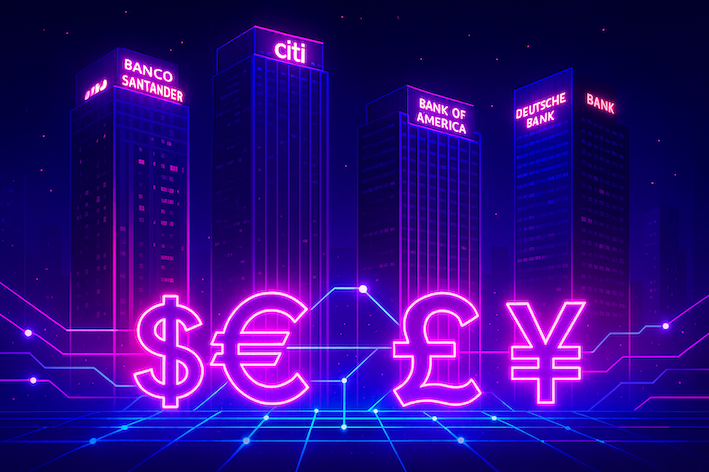In recent years, the financial industry has been on the brink of a significant transformation. With the integration of blockchain technology, some of the world’s largest banks are venturing into the creation of a new digital currency. This initiative aims to revolutionize payment systems by making transactions faster, more secure, and cost-effective. The adoption of blockchain in traditional banking indicates a forward-thinking approach that may redefine how we perceive and use money.
Global Banks and the Rise of Digital Currency
Unity Among Major Financial Institutions
Several prominent banks, including Banco Santander, Citi, Bank of America, and Deutsche Bank, are collaborating to develop a digital currency. Their efforts are joined by other banking giants such as Barclays, BNP Paribas, Goldman Sachs, MUFG, TD Bank, and UBS. According to BNP Paribas, this new digital money will be backed by real reserves, maintaining a 1:1 parity with the currencies of the G7 nations. These countries include the United States, Canada, France, Germany, Italy, Japan, and the United Kingdom. The objective is to create a stable digital currency that instills confidence, particularly among skeptics of blockchain technology.
Distinct Features of the Proposed Digital Currency
The envisioned system will operate on a public blockchain, ensuring secure and transparent transactions. Unlike typical cryptocurrencies such as Bitcoin, the value of these new tokens will remain stable, as each unit will be backed by real money held in a bank account. This blend of digital efficiency and traditional security offers advantages such as speed, low costs, and global reach. Experts view this as a logical evolution: banks maintain control while customers reap the benefits of cutting-edge technology.
The Mainstream Adoption of Stablecoins
Initially, stablecoins were used primarily by crypto traders for quick exchanges between digital assets. However, their appeal has broadened. Major corporations like Meta and Amazon now recognize the advantages of stable digital currencies, and banks are realizing the necessity of developing their own solutions to remain competitive.
In the United States, the passing of the GENIUS Act in July established regulatory frameworks for the use and trade of stablecoins, encouraging banks to take more active roles. This regulatory clarity has bolstered trust and signified that digital currencies are no longer niche products.
Significance of the Digital Currency Initiative
The banks involved in this initiative aim to determine if a unified digital monetary system can enhance market dynamics by increasing competition, simplifying processes, and reducing costs. They are committed to adhering to all legal requirements while pursuing these goals. Although some experts warn that such projects could centralize power among large banks, others highlight the benefits: faster payments around the clock, increased transparency, and reduced reliance on intermediaries. A successful implementation could set a precedent for other countries and financial institutions around the world.
A Leap into the Future of Money
According to Standard Chartered, stablecoins could draw up to one trillion US dollars in deposits from developing countries over the next few years, highlighting the vast potential of this technology. For participating banks, this is a prime opportunity to lead innovation rather than merely respond to it. By integrating blockchain with traditional banking, a new form of money — digital, secure, and globally accessible — could emerge. This project might be more than just an experiment; it could herald the dawn of a new era in the financial ecosystem.
$MAXI – Embracing the Meme Market
$MAXI, the official token of Maxi Doge, represents a contemporary evolution of the original Dogecoin meme. While Dogecoin laid the foundation for meme coins, Maxi Doge embodies the next generation: energetic, ambitious, and growth-oriented. The token merges the humor and light-heartedness of meme culture with the identity of a proactive, globally connected trading community. Built on a robust blockchain infrastructure, $MAXI is targeting listings on leading decentralized and centralized exchanges.
Maxi Doge’s Aspiration to Surpass DOGE
To further its reach, Maxi Doge plans to host gamified trading events and community contests, fostering long-term engagement. For investors, $MAXI offers significant momentum. Meme coins like $MAXI thrive on viral attention, rapid capital flow, and social engagement, creating an environment ripe for short-term opportunities. However, the meme coin market is highly volatile. Price movements are often driven by hypes, influencer posts, and market sentiment rather than fundamental values. Therefore, investors in $MAXI should be aware of the risks and understand the dynamics of trends that can ascend as swiftly as they plummet.
Frequently Asked Questions
How are digital currencies backed by real reserves?
Digital currencies like the one proposed are tied to actual reserves held in bank accounts. Each unit of digital currency corresponds to a defined amount of a traditional currency, ensuring its value remains stable and trustworthy.
What are the potential risks of centralizing digital currency with banks?
Centralizing digital currency with banks might increase their influence over the financial system. This could potentially limit competition and innovation if not regulated properly, although it also offers heightened security and trust.
Why are stablecoins significant for major corporations?
Stablecoins provide a reliable digital payment method that is resilient against the volatility typically associated with cryptocurrencies. This stability makes them attractive to corporations for global transactions and payment systems.
What should investors consider before investing in $MAXI?
Investors should evaluate the highly volatile nature of meme coins, marked by swift price changes influenced by social media and market trends. Due diligence on market trends and understanding of potential risks are crucial before investing.

